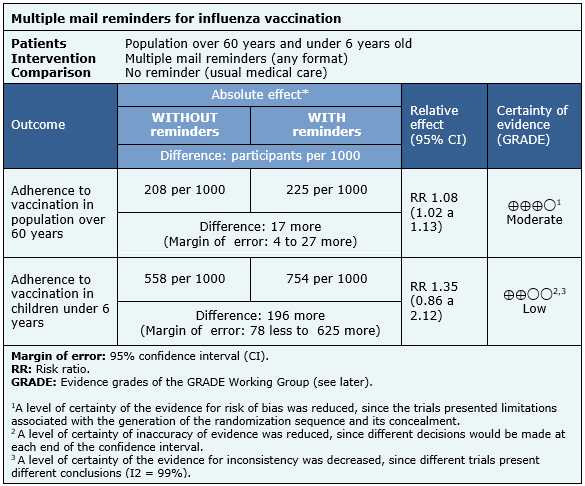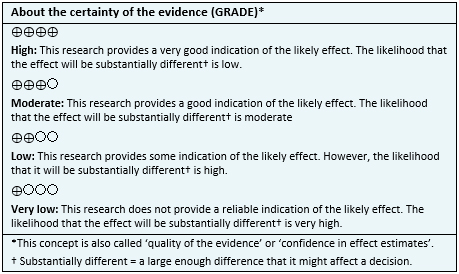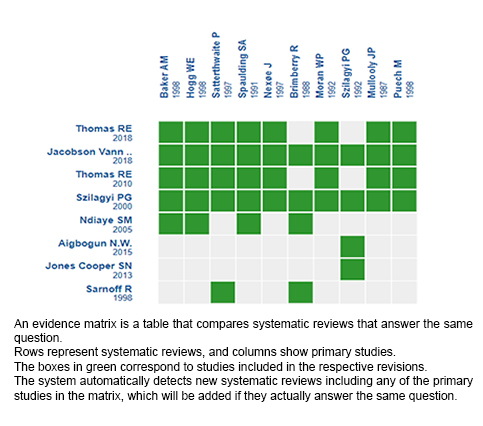Resúmenes Epistemonikos
← vista completaPublicado el 15 de julio de 2020 | http://doi.org/10.5867/medwave.2020.06.7962
Recordatorio a través de múltiples cartas para vacunación contra influenza
Multiple mail reminders to increase adherence to influenza vaccination
Abstract
INTRODUCTION Different interventions have been proposed to reinforce the use of the influenza vaccine. The use of reminders, whether through letters, phone calls, pamphlets or technological applications, among others, has stood out among those aimed at increasing ad-herence to treatment. However, its effectiveness is not clear. In this summary, which is part of a series of reminder evaluations, we assess the use of multiple mail reminders.
METHODS We conducted a search in Epistemonikos, the largest database of systematic health reviews, which is maintained by screening multiple sources of information, including MEDLINE, EMBASE, Cochrane, among others. We extracted the data from the identified reviews, analyzed the data from the primary studies, performed a meta-analysis and prepared a summary table of the results using the GRADE method.
RESULTS AND CONCLUSIONS We identified eight systematic reviews including 35 primary studies, of which four analyze the use of more than one letter as a reminder. We conclude that the use of multiple mail reminders probably increase adherence to influenza vaccination in patients over 60; while it may make little or no difference in children under 6 years, but the certainty of the evidence is low.
Problem
Influenza is an acute respiratory disease caused by the influenza virus that can be prevented with a seasonal vaccine. Despite this, it remains an important cause of morbidity and mortality [1] since it is estimated that annual influenza epidemics cause 3-5 million serious cases of the disease and 290 000 to 650 000 deaths [2]. Additionally, these are associated with significant school and work absenteeism, generating significant productivity losses [2].
Various interventions have been proposed to increase the use of the influenza vaccine. Reminders can be provided through different communication channels: letters, phone calls, pamphlets or technological applications, among others. This article is part of a series of publications aimed at evaluating the use of reminders and will focus on the effects of sending two or more letters, postcards or pamphlet type reminders via traditional mail.
Methods
We conducted a search in Epistemonikos, the largest database of systematic health reviews, which is maintained through searches in multiple sources of information, including MEDLINE, EMBASE, Cochrane, among others. We extracted the data from the identified reviews and analyzed the data from the primary studies. With this information, we generate a structured summary called FRISBEE (Friendly Summaries of Body of Evidence using Epistemonikos), following a pre-established format, which includes key messages, a summary of the set of evidence (presented as an evidence matrix in Epistemonikos), meta-analysis of the total of the studies when possible, a summary table of results with the GRADE method and a section of other considerations for decision-making.
|
Key messages
|
About the body of evidence for this question
|
What is the evidence. |
We found eight systematic reviews [3], [4], [5], [6], [7], [8], [9], [10] including 35 primary studies reported in 34 references [11], [12] , [13], [14], [15], [16], [17], [18], [19], [20], [21], [22], [23], [24], [ 25], [26], [27], [28], [29], [30], [31], [32], [33], [34], [35], [36], [37] , [38], [39], [40], [41], [42], [43], [44] of which, 32 are randomized trials reported in 31 references [11], [12], [13 ], [14], [15], [16], [17], [18], [19], [20], [21], [22], [23], [24], [25], [26], [27], [28], [29], [30], [31], [32], [33], [34], [35], [36], [37], [38 ], [39], [40], [41]. Five trials were excluded [16], [18], [21], [33], [35] because they included co-interventions to increase influenza vaccination. Twenty-two trials were excluded [11], [12], [13], [14], [15], [17], [20], [22], [23], [25], [26], [28 ], [29], [30], [32], [34], [36], [37], [38], [39], [40], [41] because the intervention consisted of a single mail reminder, which has already been analysed [45] . In addition, observational studies [42], [43], [44] did not increase the certainty of the evidence, nor provided any additional relevant information. This table and the summary in general are based on four randomized trials [19], [24], [27], [31]. |
|
What types of patients were included* |
The trials included a total of 71 458 participants of all ages, including targeted risk population such as children over six months up to six years and adults over 60 years. Two trials included children [19], [24] and two trials included older adults (over 60 years old) [27], [31]. In general, the trials excluded patients who had already received the vaccine prior to the start of the trial, with egg allergy or participants living in nursing homes. |
|
What types of interventions were included* |
All trials evaluated the use of multiple reminders, defined as more than one reminder sent by traditional mail [24], [31], [19], [27]. All included trials compared against usual medical care. |
|
What types of outcomes |
This systematic reviews identified only evaluated the adherence to the vaccine (influenza vaccination rate). The average follow-up of the trials was seven months, ranging from six to 11 months. |
* Information about primary studies is not extracted directly from primary studies but from identified systematic reviews, unless otherwise stated.
Summary of findings
Information on the effects of multiple mail reminders is based on four randomized trials that included 71 458 patients [19], [24], [27], [31].
Of these, two trials included population under 6 years with a total of 7 044 participants [19], [24], while the other two included population over 60 years with a total of 64 414 participants [27], [31].
All trials measured the outcome adherence to vaccination.
The summary of findings is as follows:
- Multiple mail reminders probably increase adherence to influenza vaccination in people over 60 years.
- Multiple mail reminders may make little or no difference to adherence to influenza vaccination in children under six years.

| Follow the link to access the interactive version of this table (Interactive Summary of Findings – iSoF) |

Other considerations for decision-making
|
To whom this evidence does and does not apply |
|
| About the outcomes included in this summary |
|
| Balance between benefits and risks, and certainty of the evidence |
|
| Resource considerations |
|
| What would patients and their doctors think about this intervention |
|
|
Differences between this summary and other sources |
|
| Could this evidence change in the future? |
|
How we conducted this summary
Using automated and collaborative means, we compiled all the relevant evidence for the question of interest and we present it as a matrix of evidence.

Follow the link to access the interactive version: Mail reminders to increase adherence to influenza vaccination.
Notes
The upper portion of the matrix of evidence will display a warning of “new evidence” if new systematic reviews are published after the publication of this summary. Even though the project considers the periodical update of these summaries, users are invited to comment in Medwave or to contact the authors through email if they find new evidence and the summary should be updated earlier.
After creating an account in Epistemonikos, users will be able to save the matrixes and to receive automated notifications any time new evidence potentially relevant for the question appears.
This article is part of the Epistemonikos Evidence Synthesis project. It is elaborated with a pre-established methodology, following rigorous methodological standards and internal peer review process. Each of these articles corresponds to a summary, denominated FRISBEE (Friendly Summary of Body of Evidence using Epistemonikos), whose main objective is to synthesize the body of evidence for a specific question, with a friendly format to clinical professionals. Its main resources are based on the evidence matrix of Epistemonikos and analysis of results using GRADE methodology. Further details of the methods for developing this FRISBEE are described here (http://dx.doi.org/10.5867/medwave.2014.06.5997)
Epistemonikos foundation is a non-for-profit organization aiming to bring information closer to health decision-makers with technology. Its main development is Epistemonikos database (www.epistemonikos.org).
Potential conflicts of interest
The authors do not have relevant interests to declare.

